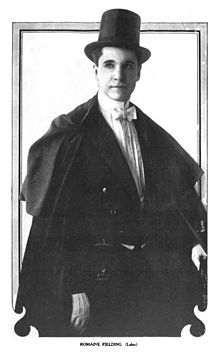Romaine Fielding
| Romaine Fielding | |
|---|---|

Motion Picture Magazine (August, 1915) Vol. X No.7, New York
|
|
| Born |
William Grant Blandin May 22, 1867 Riceville, Iowa, USA |
| Died | December 16, 1927 (aged 60) Hollywood, California, USA |
| Nationality | American |
| Occupation | Actor |
| Known for | Western films |
Romaine Fielding (May 22, 1867 – December 15, 1927), was an American actor, screenwriter and silent film director known for his dramatic westerns.
Fielding was born William Grant Blandin in Iowa. Although without medical training, at one time he ran a medical practice in Kansas City, Missouri. He prospected for gold in Alaska, where he made friends with Jack London and Rex Beach, both of whom would influence his work in films. He also worked as a travel agent, machinist and railway engineer before becoming an actor under the name of Romaine Fielding. He married Mabel van Valkenburg in 1907 but divorced ten years later. He worked and acted in live theatre for a number of years. Fielding worked for the Solax Company of New York before joining Philadelphia-based Lubin Studios in November 1911 at the age of forty-four. Despite his age, he could easily portray much younger characters.
In June 1912 Siegmund Lubin placed Fielding in charge of the Lubin Southwest Company as director, despite the fact that until now he had only acted. This was the start of a rapid rise to fame, where Fielding would write and direct films as well as starring. He broke with convention, challenging stereotypical casting of Indians and Mexicans as villains. His films often ended unexpectedly on a downbeat note. His work was praised in the trade press for its visual beauty combined with realism.
Fielding directed films in the old streets of Tucson in 1912, then moved north to Prescott to film stories based on old west mining and Indian life. He used many local people as extras. Towards the end of 1912 he moved his company down to Nogales. In March 1913 he crossed into Mexico with his company, and was able to film the Battle of Nogales as it happened. He later directed and filmed additional battle scenes, then spliced the real and artificial footage to give the sense of the battle having been filmed from both sides. From there he took his company to Silver City, New Mexico, where he rented two houses and built an outdoor stage for shooting interior scenes. He made use of abandoned structures to film spectacular fires or explosions, which formed the highlights of his fresh and realistic films, typically dark human tragedies.
...
Wikipedia
